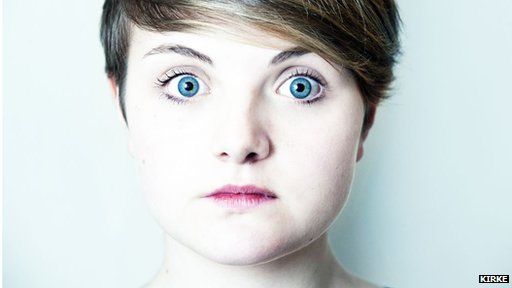Many Worlds: The movie that watches its audience
- Published

Have you ever sat watching a film through the gaps between your fingers? Ever leapt out of your seat at an unexpected hair-tingling dramatic moment in a blockbuster, or been so lulled by the slowness and general inactivity of the characters on the screen that you momentarily fell asleep and missed a key moment in the film?
Well rest assured you need never be concerned too much by any of the above thanks to the innovative use of sensors employed by the composer, and now film-maker, Alexis Kirke.
The Plymouth-based creative has made Many Worlds, a film that watches audience members as they watch it, allowing them to influence the sequence of scenes as the film unfolds.
Click Radio talks to Alexis Kirke
The film was developed at the interdisciplinary centre for computer music research at Plymouth University in the UK. Through it, Mr Kirke is rethinking the way we watch movies by building on his previous research into the use of bio-signals to detect people's emotions and their state of minds.
But the technology involved is not being demonstrated in a scientific lab or specialist conference but rather it will be shown to the public at a festival later in the month.
Arousal analysis
The story starts with two students arriving at a friend's house to celebrate her birthday, but instead they find themselves involved in a bizarre scientific experiment.
The goal is for the audience to become immersed in the plot. The twist is that as they do so their emotions are used to direct the movie's progress, editing it in real time.
"One day we may be able to put a camera at the front of the cinema to pick up the arousal of the entire audience," Mr Kirke tells the BBC. But for now he is starting more simply.
For the technology to work, the filmmaker requires four volunteers from the audience to be attached to sensors.
One viewer's heart rate will be monitored, another's brain waves will be tracked, a third's level of perspiration will be observed, and the final volunteer will have a device strapped to their arm to measure muscle tension.
These are all indicators, Mr Kirke suggests, of physical arousal that can then be fed into a computer and analysed in real time.
Off-the-peg software tools already exist that can utilise this real-time analysis to change the direction or scenes in a movie.
Four endings
To test his hypothesis, Mr Kirke has made his own short film building in a number of junctions where alternative narratives can be played out, depending on the emotional trigger provided by the monitored audience member.
In effect he has made a movie that can branch off into multiple divergent story lines when activated.
"The actors have had to act out four different films within one overall film" he says.
Ahead of the premiere, the film-maker came to BBC Broadcasting House to test his creation on the World Service's Gareth Mitchell, who had a muscle sensor strapped to his arm.
After calibrating the device to establish a baseline of the Click presenter's emotional state, Mr Kirke then played footage that diverged from its expected narrative.
When Mr Mitchell started to get tense, the film flicked to a more relaxing sequence. But when the journalist was later encouraged to relax, the footage at the next branch point switched to a dramatic moment with an undercurrent of expected violence.
First step
It may seem revolutionary but others have tried something similar before, says tech writer Bill Thompson.
Back in 1967 the world witnessed its first interactive film, Kinoautomat, during which a moderator appeared on stage and stopped the film at nine "decision" points, asking the audience to vote on the direction - one of two choices - in which the film should proceed.
Wiring up the volunteers means the branch points are less disruptive to the movie's flow, but "four people do not necessarily constitute a statistical sample," adds Thompson.
"This is clearly an experiment. The question is will you, the viewer 'drop out' of the film narrative because it's detecting you; and will the story telling be seamless enough for it to feel more like you're playing a game which takes you in a direction you sort of want to go in?"
This fledgling interactive film is a first step, but a more rigorous test will require a film to be made with many more decision points than Mr Kirke and his collaborators have been able to engineer.
Nonetheless, the film-maker believes that it is inevitable that this kind of technology will be embraced by all the major studios from Hollywood to Bollywood.
It could put an end, thinks Mr Kirke, to the obsession with audience test screenings of multiple endings before a film is released. In the future, he believes the director will relinquish control to the audience's collective emotional state.
Many Worlds, is premiered at the Peninsula Arts Contemporary Music Festival on 23 February.
- Published26 November 2011
- Published22 November 2012
- Published8 March 2012